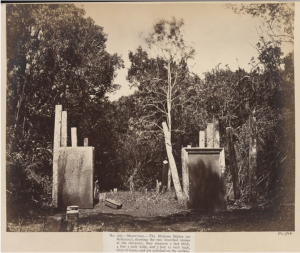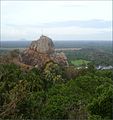OB03026 Anuradhapura Slab of Mahinda IV
IN03031 Anuradhapura Slab Inscription of Mahinda IV
The inscription of 49 lines is written in the same style and language than the two tablets of Mihintale (IN3030). It was engraved just a few months later than those ones, during the reign of the king Mahinda IV (975-91 A.D.). It records rules for the administration of certain lands and villages. It also contains an important mention of the temple of the Buddha’s ‘Tooth-relic’ (Daḷ-dā-ge), which enabled the identification of this temple, rebuilt by Mahinda IV in the centre of the town, as the ruined site known as the Daḷadā Māligāva, situated south-east of the Thūparāma dāgäba.
OB03025b Mihintale Tablet B
OB03025a Mihintale Tablet A
OB03025 Mihintale Tablets of Mahinda IV

Mihintale. The Bhójana Sáláwa (or Refrectory), showing the two inscribed stones at the entrance. Photographed by Joseph Lawton (d. 1872) active in Sri Lanka between 1866 and 1872. V&A 82756
IN03030 Mihintale Inscription of Mahinda IV
The inscription is written on two granite slabs, which stand near the old refectory, also called Bhōjana-sālā, on the left of the third set of steps (on four) on the western slope of the hill at Mihintale. The inscription is divided equally between the two slabs, each one bearing 58 lines of Sinhalese prose. They were installed by the king Mahinda IV (975-91 A.D.) and record rules and regulations for the administration of the monastery (the name of the monastery is not mentioned) and payments made to the service staff.
OB03024 Perimiyankulam Rock
IN03029 Perimiyankulam Rock Inscription
The inscription was found near Perimiyankulam or Perumäiyaṉ-kuḷam, “the tank of the great personage”, or Perumäiyāṉa-kuḷam, “the great tank”, situated on the path to Galkaḍawala, one and a half miles north of the Sacred Bōdhi-tree at Anurādhapura. Müller (1883: 27) describes the inscription as “on a flat rock by the side of a hollowed-out cave”. There are many stone pillars near the place, which is north-west of the Laṅkārāmaya. The inscription is on the whole very well preserved. It consists of 4 lines recording a gift of revenue, derived from water supply in Palinakaraka tank in Tihalaka-karisa and in Ketavalika tank at Amanaratana, to a thēra named Majibuka (or -bika) for looking after certain dilapidated buildings at Patnagala belonging to the architect Ayisayi, son of Batakaya, keeper of the royal store.
OB03023 Maha-Ratmale Slab Rock
IN03028 Maha-Ratmale Rock Inscription
The inscription is situated in the ruins of an ancient site, close by the Ratmale wewa, south-west from Anurādhapura, not far from the Kurunegala Road. Four lines are engraved on a large slab rock. The inscription mentions three names of kings: Devānapiya Tisa-maharaja, Devānapiya Puṭikaṇa Gamiṇi Abhaya-maharaja, Devānapiya Naka-maharaja. These have been identified by Goldschmidt and Müller as the kings Vaṅkanāsika Tissa, Gaja-bāhu and Mahallaka Nāga of the Mahāvaṁsa. The inscription records the donation from the king Mahallaka Nāga (circa A.D. 135-141) of gruel, boiled rice, undergarments and silk outer garments for the Vassa ceremony to 20 monks at Vihirabijaka and at Muṭigulika and Parivataka monasteries.
